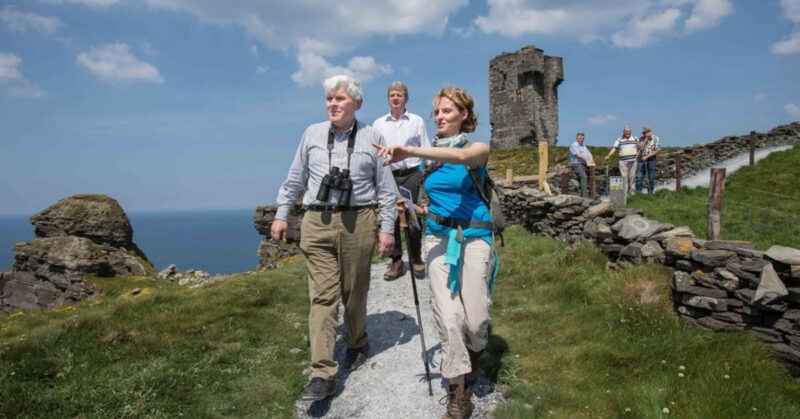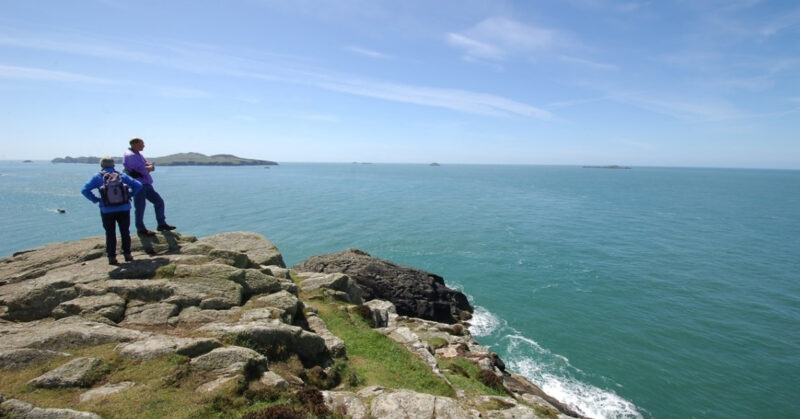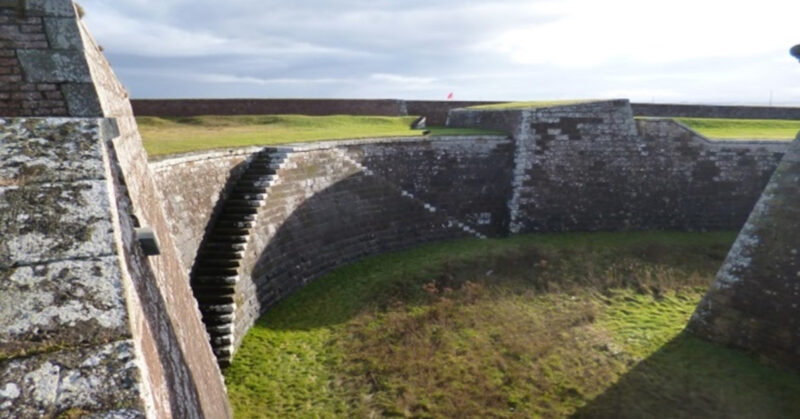This guidance considers options for controlling the risks arising from unprotected drops. These may be natural hazards, such as cliffs; or man-made hazards, like drops from battlements, fortifications and other historic structures.
Hazard means anything that can cause harm. Risk is the likelihood, high or low, that somebody will be harmed by the hazard.

Cliffs of Moher, County Clare, Ireland
We follow the VSG guiding principles. These stress the importance of considering, first and foremost, risk control measures that do not restrict public access or conflict with heritage and conservation objectives. In consequence it is neither desirable nor practicable for all drops to be eliminated or fenced.

Carew, Pembrokeshire, Wales
Society accepts the existence of unprotected drops in public places. Traditionally people have been free to walk alongside unfenced quaysides, lock sides, city walls and cliff tops.

St David’s Head, Pembrokeshire, Wales
The very nature of our countryside means that eliminating the hazard is unlikely to be practicable. For example, we would not wish to remove dramatic cliffs and crags from the landscape, nor deny access to them.

Unguarded drops from the platform and steps at Fort George, Inverness, Scotland
Similarly heritage and conservation considerations usually mean it is unreasonable to remove the hazard of drops from historic buildings. It is usually not permissible (or desirable) to alter scheduled monuments and listed buildings by erecting barriers or fences.
In consequence, although we believe that our recommendations are consistent with the principles of prevention established by health and safety legislation, it is often inappropriate to eliminate the drops or deny public access. The final choice of risk controls therefore reflects the difference between managing risk for people using the countryside for sport and recreation of their own free will, and the duties of an employer to his employees in the workplace.
This guidance considers options for controlling the risks arising from unprotected drops. These may be natural hazards, such as cliffs; or man-made hazards, like drops from battlements, fortifications and other historic structures.
Hazard means anything that can cause harm. Risk is the likelihood, high or low, that somebody will be harmed by the hazard.

Cliffs of Moher, County Clare, Ireland
We follow the VSG guiding principles. These stress the importance of considering, first and foremost, risk control measures that do not restrict public access or conflict with heritage and conservation objectives. In consequence it is neither desirable nor practicable for all drops to be eliminated or fenced.

Carew, Pembrokeshire, Wales
Society accepts the existence of unprotected drops in public places. Traditionally people have been free to walk alongside unfenced quaysides, lock sides, city walls and cliff tops.

St David’s Head, Pembrokeshire, Wales
The very nature of our countryside means that eliminating the hazard is unlikely to be practicable. For example, we would not wish to remove dramatic cliffs and crags from the landscape, nor deny access to them.

Unguarded drops from the platform and steps at Fort George, Inverness, Scotland
Similarly heritage and conservation considerations usually mean it is unreasonable to remove the hazard of drops from historic buildings. It is usually not permissible (or desirable) to alter scheduled monuments and listed buildings by erecting barriers or fences.
In consequence, although we believe that our recommendations are consistent with the principles of prevention established by health and safety legislation, it is often inappropriate to eliminate the drops or deny public access. The final choice of risk controls therefore reflects the difference between managing risk for people using the countryside for sport and recreation of their own free will, and the duties of an employer to his employees in the workplace.
[block_anchor] => [block_format] => custom_subnav [block_introduction_title] => [block_custom_subnav] => [block_section_heading] => [product] => [product_text] => ) [1] => stdClass Object ( [block_count] => 1 [layout] => post_list [slug] => block-938bba8b [title] => [source] => page [visibility] => 1 [background_colour] => bg-transparent [block_width] => container [width] => stdClass Object ( [container_class1] => container mb-4 [container_class2] => bg-transparent py-4 [container_class3] => ) [class] => fcb-post_list [posts] => Array ( [0] => WP_Post Object ( [ID] => 7179 [post_author] => 18 [post_date] => 2021-08-03 13:14:35 [post_date_gmt] => 2021-08-03 12:14:35 [post_content] => [post_title] => Risk Assessment Process [post_excerpt] => [post_status] => publish [comment_status] => closed [ping_status] => closed [post_password] => [post_name] => risk-assessment-process [to_ping] => [pinged] => [post_modified] => 2021-08-05 10:50:19 [post_modified_gmt] => 2021-08-05 09:50:19 [post_content_filtered] => [post_parent] => 47 [guid] => https://www.visitorsafety.group/?page_id=7179 [menu_order] => 1 [post_type] => page [post_mime_type] => [comment_count] => 0 [filter] => raw ) [1] => WP_Post Object ( [ID] => 7183 [post_author] => 18 [post_date] => 2021-08-03 14:39:55 [post_date_gmt] => 2021-08-03 13:39:55 [post_content] => [post_title] => Options for Risk Control [post_excerpt] => [post_status] => publish [comment_status] => closed [ping_status] => closed [post_password] => [post_name] => options-for-risk-control [to_ping] => [pinged] => [post_modified] => 2021-08-03 14:45:25 [post_modified_gmt] => 2021-08-03 13:45:25 [post_content_filtered] => [post_parent] => 47 [guid] => https://www.visitorsafety.group/?page_id=7183 [menu_order] => 1 [post_type] => page [post_mime_type] => [comment_count] => 0 [filter] => raw ) [2] => WP_Post Object ( [ID] => 7192 [post_author] => 18 [post_date] => 2021-08-03 14:47:50 [post_date_gmt] => 2021-08-03 13:47:50 [post_content] => [post_title] => Emergency Response [post_excerpt] => [post_status] => publish [comment_status] => closed [ping_status] => closed [post_password] => [post_name] => emergency-response [to_ping] => [pinged] => [post_modified] => 2021-08-03 14:47:50 [post_modified_gmt] => 2021-08-03 13:47:50 [post_content_filtered] => [post_parent] => 47 [guid] => https://www.visitorsafety.group/?page_id=7192 [menu_order] => 1 [post_type] => page [post_mime_type] => [comment_count] => 0 [filter] => raw ) [3] => WP_Post Object ( [ID] => 7195 [post_author] => 18 [post_date] => 2021-08-03 14:57:14 [post_date_gmt] => 2021-08-03 13:57:14 [post_content] => [post_title] => Types of Barrier [post_excerpt] => [post_status] => publish [comment_status] => closed [ping_status] => closed [post_password] => [post_name] => types-of-barrier [to_ping] => [pinged] => [post_modified] => 2021-08-03 14:59:04 [post_modified_gmt] => 2021-08-03 13:59:04 [post_content_filtered] => [post_parent] => 47 [guid] => https://www.visitorsafety.group/?page_id=7195 [menu_order] => 1 [post_type] => page [post_mime_type] => [comment_count] => 0 [filter] => raw ) ) [list_style] => standard [posts_per_row] => 3 [block_anchor] => ) ) 1